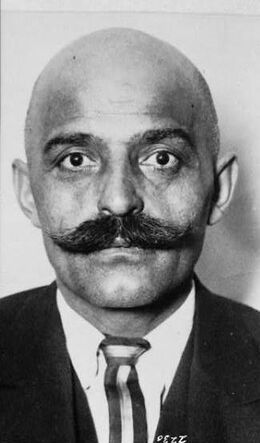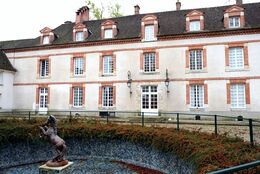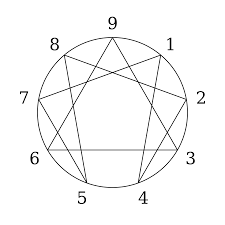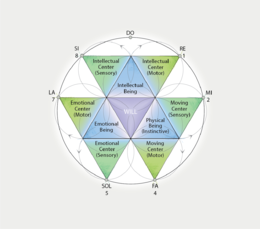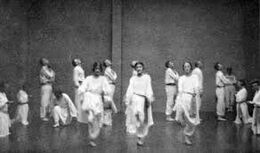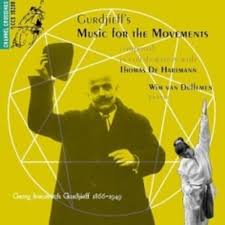Georges Ivanovich Gurdjieff: Difference between revisions
No edit summary |
No edit summary |
||
| Line 141: | Line 141: | ||
The role of the movements is nothing less than to bring attention to the whole person - body, mind and feelings, while maintaining a level of consciousness of one's surroundings-- the teacher's instructions, the other pupils, the music. | The role of the movements is nothing less than to bring attention to the whole person - body, mind and feelings, while maintaining a level of consciousness of one's surroundings-- the teacher's instructions, the other pupils, the music. | ||
Gurdjieff stated in his first talk in Berlin in 1921: < blockquote> | Gurdjieff stated in his first talk in Berlin in 1921: <blockquote> | ||
<i>You ask about the aim of the movements. To each position of the body corresponds a certain inner state and, on the other hand, to each inner state corresponds a certain posture. A man, in his life, has a certain number of habitual postures and he passes from one to another without stopping at those between. Taking new, unaccustomed postures enables you to observe yourself inside differently from the way you usually do in ordinary conditions. </i>”<ref>Gurdjieff Halifax Organization. <i>The Movements</i>. https://www.gurdjieffhalifax.org/the-movements# Accessed on 4/11/24</ref>. | <i>You ask about the aim of the movements. To each position of the body corresponds a certain inner state and, on the other hand, to each inner state corresponds a certain posture. A man, in his life, has a certain number of habitual postures and he passes from one to another without stopping at those between. Taking new, unaccustomed postures enables you to observe yourself inside differently from the way you usually do in ordinary conditions. </i>”<ref>Gurdjieff Halifax Organization. <i>The Movements</i>. https://www.gurdjieffhalifax.org/the-movements# Accessed on 4/11/24</ref>.</blockquote> | ||
The feature film <i>Meetings with Remarkable Men</i> (1979), loosely based on Gurdjieff's book by the same name, ends with performances of Gurdjieff's dances known simply as the "exercises" but later promoted as movements. Jeanne de Salzmann and Peter Brook wrote the film and Brook directed it. <ref>Panafieu, Bruno De; Needleman, Jacob; Baker, George (September 1997).</ref> <ref>Gurdjieff: Essays and Reflection on the Man and His Teachings.</i> Continuum International Publishing Group. p 28. https://books.google.com/books?id=GV0dhZxB91EC&pg=PA28#v=onepage&q&f=false Accessed 3/29/24</ref> | The feature film <i>Meetings with Remarkable Men</i> (1979), loosely based on Gurdjieff's book by the same name, ends with performances of Gurdjieff's dances known simply as the "exercises" but later promoted as movements. Jeanne de Salzmann and Peter Brook wrote the film and Brook directed it. <ref>Panafieu, Bruno De; Needleman, Jacob; Baker, George (September 1997).</ref> <ref>Gurdjieff: Essays and Reflection on the Man and His Teachings.</i> Continuum International Publishing Group. p 28. https://books.google.com/books?id=GV0dhZxB91EC&pg=PA28#v=onepage&q&f=false Accessed 3/29/24</ref> | ||
Revision as of 14:12, 13 April 2024
Georges Ivanovich Gurdjieff was a mystic, philosopher, esoteric writer, spiritual teacher, composer, and choreographer of Armenian and Greek descent. He was born in Alexandropol, Armenia (back then part of the Russian Empire) in the late 19th century, with his birth date often cited as January 13, 1866. He is best known for his teachings on self-awareness and self-improvement, which he referred to as "The Work" or "The Fourth Way." Gurdjieff worked first in Russia and later in France and became known as a teacher and founder of a worldwide and widespread following.
Gurdjieff established the Institute for the Harmonious Development of Manin 1919 at Tiflis (now Tbilisi), Georgia, where he taught his ideas through a combination of lectures, music, dance (Movements), and group work. It was reestablished at Fontainebleau, France, in 1922. [1]
Gurdjieff is known for his charismatic personality and idiosyncratic, improvisatory methods of teaching and his life and teachings have been explored and critiqued in countless publications. [2]
Some of his students called the Gurdjieff approach “A method of Conscious Effort and Voluntary Suffering against INERTIA and REPETITION.” He died on October 29, 1949, in Neuilly-sur-Seine, France. His legacy continues through the work of various Gurdjieff foundations and groups around the world. [3]
Early Life
The very date of Gurdjieff’s birth is in dispute, although he himself stipulates 1866. [4] Between his birth and 1912 biographers have to be reliant on Gurdjieff's own four impressionistic accounts, which are not very consistent. Notoriously problematical are 'the missing twenty years' from 1887 to 1907. [5]
Based on Gurdjieff’s account, he grew up in the volatile Caucasus region located between Christian Orthodox Russia and Islamic Turkey, Iraq, and Persia. His family moved from Alexandropol to Kars shortly after its recapture by Russia from the Turks. There he was tutored by the Dean of the Russian Orthodox Cathedral and later by Bogachevsky, a candidate for the priesthood, who tutored him in the Christian precepts. Gurdjieff revered this teacher all his life.
Coming "to the whole sensation" of himself at an early age and recognizing the mindless mechanicality of human life, the question arose within Gurdjieff—what is the meaning and purpose of life on earth and of human life in particular?[6]
Gurdjieff's search for such knowledge led him to travel widely, seeking out sacred cities and sites through the Middle East and Central Asia in pursuit of esoteric knowledge. The only account of his wanderings appears in his book Meetings with Remarkable Men.[7] He arrived in Moscow in 1912 with the groundwork of his teaching formulated and began gathering pupils. He founded an Institute in 1918, which eventually became the Institute for the Harmonious Development of Man.. It began in Essentuki in the Caucasus, and moved to Tiflis then Constantinople, Berlin, and finally, in October 1922, at the Château Le Prieuré at Fontainebleau-Avon where it functioned until 1932. [8]
Institute for the Harmonious Development of Man
Gurdjieff first established the Institute for the Harmonious Development of Manin 1919 at Tiflis (now Tbilisi), Georgia, where he taught his ideas through a combination of lectures, music, dance (Movements), and group work. [9]
After escaping the Russian revolution with dozens of followers and family members, Gurdjieff settled in France and reestablished the Institute for Harmonious Development of Man at the Château Le Prieuré at Fontainebleau-Avon in October of 1922.
Gurdjieff was of the opinion that modern man's world perception and his own mode of living are not the conscious expression of his being taken as a complete whole. Quite on the contrary, they are only the unconscious manifestation of one or another part of him.
Thus, members living at the institute, many from prominent backgrounds, lived a virtually monastic life, except for a few banquets, at which Gurdjieff would engage in probing dialogue and at which his writings were read. Ritual exercises and dance were also part of the regimen, often accompanied by music composed jointly by Gurdjieff and an associate, the composer Thomas de Hartmann. Performers from the institute appeared in Paris in 1923 and in three U.S. cities the following year and brought considerable attention to Gurdjieff’s work. [10]
Gurdjieff’s Work and Ideas
The Fourth Way
Gurdjieff's Fourth Way is a spiritual teaching that combines elements of Eastern and Western philosophy and religion. It is called the Fourth Way because it is said to be a path that integrates the three traditional ways of spiritual development:
the way of the fakir (physical discipline), the way of the monk (emotional devotion), and the way of the yogi (mental concentration).
The Fourth Way emphasizes the development of consciousness and self-awareness while living an ordinary life in the world, rather than through withdrawal from the world as in monastic or ascetic practices. Gurdjieff believed that most people live their lives in a state of "waking sleep," and that true spiritual awakening requires conscious effort and work on oneself.
Key concepts of the Fourth Way include:
1. Self-observation: Paying attention to one's thoughts, emotions, and actions in the present moment without judgment or identification. Gurdjieff also called this “conscious suffering”.
2. Self-remembering: A practice of maintaining awareness of oneself and one's surroundings simultaneously, to be present and not lost in identification with thoughts or emotions.
3. The Enneagram: A geometric symbol used as a tool for understanding the dynamics of personality and the processes of transformation. 4. Three Centers: The idea that humans have three centers of functioning - intellectual, emotional, and physical - and that balanced development of these centers is essential for spiritual growth.
5. Identification and Non-identification: Learning to detach from identifying with one's thoughts, emotions, and roles in life.
6. Internal and External Considering: Balancing one's own needs and interests with those of others in interactions.
Gurdjieff's teachings were not systematic and were often transmitted orally through direct work with his students. He used various methods, including group work, music, dance (Movements), and practical tasks, to help students develop self-awareness and inner growth.
The Fourth Way has influenced various spiritual and self-development movements and continues to be studied and practiced by groups around the world. [11] [12][13][14][15]
The Enneagram
Gurdjieff introduced the enneagram to the modern world in 1914, stating that it is a schematic diagram that was preserved in secret for a long time and could only be understood by those who knew it meaning. [16] It can be traced back at least as far as the works of Pythagoras. [17] The Enneagram is a symbol and a concept that plays a significant role in Grudjieff’s teachings. It is a nine-pointed geometric figure that Gurdjieff introduced to his students as a tool for understanding the laws governing the universe and human behavior. Each point on the Enneagram is said to represent a specific type of process or function, and the interactions among these points are used to describe the dynamics of various systems, including psychological, cosmological, and spiritual systems. Under Gurdjieff, the Enneagram was a tool for teaching his students about the dynamics of self-development and spiritual growth and was not used as a personality typing system, which is a common modern interpretation of the Enneagram. Instead, it is a symbol of the unity of the laws of the universe, representing the interconnection of the laws of three and seven, which Gurdjieff referred to as the Law of Three and the Law of Seven or the Law of Octaves. These laws describe the fundamental principles of transformation and evolution in the universe. [18][19]
The Law of Three and the Law of Seven
Gurdjieff's Law of Three and the Law of Seven are central to his teachings and are integral to understanding the Enneagram and the dynamics of transformation in the universe according to his philosophy. Law of Three: It states that every phenomenon in the universe is a result of the interaction of three forces: the active force, the passive force, and the neutralizing or reconciling force. These forces are also referred to as affirming, denying, and reconciling, or positive, negative, and neutral. In Gurdjieff's view, these three forces are present in every action, every process, and every moment of existence. The active force initiates or propels, the passive force resists or receives, and the neutralizing force harmonizes or balances the interaction between the active and passive forces. This triadic principle is seen as a fundamental law governing all levels of reality, from the cosmic to the human. Law of Seven:The Law of Seven, or the Law of Octaves, is based on the idea that all processes in the universe unfold in a sequence of seven stages or intervals. This law is related to the musical octave, where the eighth note is a higher repetition of the first note, completing the cycle. According to Gurdjieff, every process undergoes a development that can be divided into seven stages, each with its own characteristics. However, this development is not linear; it is subject to certain "shocks" or discontinuities that occur at specific intervals (between the third and fourth stages and between the sixth and seventh stages). These shocks are necessary for the process to continue its development and move to the next level. The Law of Seven is used to explain the dynamics of various processes, including psychological development, the unfolding of historical events, and the evolution of consciousness. It is also reflected in the structure of the Enneagram, where the points are connected in a sequence that represents the intervals of the octave. Both the Law of Three and the Law of Seven are essential for understanding Gurdjieff's view of the cosmos and the inner workings of the human being. They are interrelated and together form the basis of his teaching on the dynamics of transformation and the possibility of reaching a higher level of being. ref>Ginsburg, B. Seymor. Gurdjieff Unveiled: AN OVERVIEW AND INTRODUCTION TO GURDJIEFF'S TEACHING. Lighthouse Editions LTD; First Edition (January 1, 2005). Lesson1</ref>[20]
Seven Different Levels of Human Beings
Gurdjieff suggested that the only real evolution is the evolution of consciousness and that human consciousness can be divided into four distinct states, each relatively more conscious than the preceding state.
He divided human beings into seven categories, each with its own level of consciousness.
Human Beings No. 1 are the physical beings, No. 2 the emotional beings and No. 3 the intellectual beings. They are all on the same level but of different types, reacting differently to the same stimuli. None is better than the other – they are all at the same level of consciousness.
Human Beings No. 4 are transitional. They know what they want and need, they have a well-defined aim constantly in sight and all action are in relation to this aim. They are balanced physically, emotionally, and intellectually and continuously work on themselves.
Human Beings No. 5 have fully developed and properly equilibrated all their lower centers. They are continuously in the state of self-consciousness and have glimpses of the unitive vision.
Human Beings No. 6 truly know themselves; they are permanently in the state of self-consciousness and have made contact with their higher centers. He has acquired everything but permanence.
Human Beings No. 7 are the ones who have perfected themselves. They have free will, objective consciousness, a permanent “I”, and their own willpower. Whatever they want is always seen from and in the service of “Endlessness”. [21]
Strivings
Gurdjieff stated, that by the very fact of their existence and possibilities, every human being has duties. He set out five injunctions, which he called the “being-obligolnian-strivings. [22]
In contemporary language they are: 1. To strive to have everything satisfying and really necessary for our planetary body. 2. To strive constantly for self-perfection in the sense of being. To strive to know ever more concerning the laws of world-creation and world-maintenance. [These are the laws governing the structure of ourselves (the microcosm) and the larger universe of which we are a reflection (the macrocosm)]. 4. To strive to pay for our arising and individuality as quickly as possible. 5. To strive to assist the most rapid perfecting of other beings, both those similar to ourselves and those of other forms.[23]
Perhaps the essence of each injunction could be described as: 1. Physical health
2. Conscious development of being
3. Understanding of the nature and purpose of creation
4. Payment for what one has received and achieved
5. Service, or “helping God.” [24]
The Movements
The “sacred dances” or “Movements” were first revealed by Gurdjieff in 1919 in Tiflis), the site of the first foundation of his Institute for the Harmonious Development of Man. The proximate cause of this new teaching technique has been hypothesized to be Jeanne de Salzmann (1889–1990), an instructor of the Eurhythmics method of music education developed by Émile Jaques-Dalcroze (1865–1950). Jeanne and her husband Alexandre met at Jaques-Dalcroze’s Institute at Hellerau in 1913 and became pupils of Gurdjieff in 1919. It was to her Dalcroze class that Gurdjieff first taught Movements.
When Pyotr Demianovich Ouspensky (1878–1947) met him in 1915, he spoke of dances he had seen in Eastern temples, and was working on a never-performed ballet, The Struggle of the Magicians. Research shows, that body-based disciplines introduced by esoteric teachers with Theosophically-inflected systems are a significant phenomenon in the early twentieth century and that Gurdjieff’s Movements, while distinct from other dance systems, emerged in the same esoteric melting-pot and manifest common features and themes with the esoteric dance of Rudolf Steiner, Rudolf von Laban, Peter Deunov, and others. [25]
The role of the movements is nothing less than to bring attention to the whole person - body, mind and feelings, while maintaining a level of consciousness of one's surroundings-- the teacher's instructions, the other pupils, the music.
Gurdjieff stated in his first talk in Berlin in 1921:
You ask about the aim of the movements. To each position of the body corresponds a certain inner state and, on the other hand, to each inner state corresponds a certain posture. A man, in his life, has a certain number of habitual postures and he passes from one to another without stopping at those between. Taking new, unaccustomed postures enables you to observe yourself inside differently from the way you usually do in ordinary conditions. ”[26].
The feature film Meetings with Remarkable Men (1979), loosely based on Gurdjieff's book by the same name, ends with performances of Gurdjieff's dances known simply as the "exercises" but later promoted as movements. Jeanne de Salzmann and Peter Brook wrote the film and Brook directed it. [27] [28]
The Music
Music played a tremendous role in the life of Gurdjieff. A large and diverse body of music he composed with Ukrainian composer and pupil Thomas Alexandrovich de Hartmann (1885-1956). [29]
The music of Gurdjieff / de Hartmann is the result of an extraordinary collaboration. They composed three categories of piano music - Asian and eastern folk music, Sayyid and Dervish music, and hymns and served the advancement of self-understanding through esoteric practice. According to Gurdjieff, the deliberation of music in various forms can serve the functions of self-study and inquiry into attention.
From 1923 to 1929, Thomas de Hartmann worked closely with Gurdjieff at his Institute for the Harmonious Development of Man outside Paris, translating into European notation the music Gurdjieff composed from his travels. [30]
Gurdjieff composed three types of music:
Piano Music with de Hartmann
The Music of Movements (dances and exercises choreographed by Gurdjieff) and
Harmonium Music. [31]
In his autobiographical writings Gurdjieff describes his great admiration for the musical abilities of the “ashokhs”, or travelling bards, a profession of his father, which had fascinated him as a young boy in Kars, Turkey. [32]During his extensive travels as a young man he also described playing, singing, hearing, recording, and memorizing music, as well as becoming enthralled in the effects and properties of vibrations of sound and music. [33]
In his teaching years Gurdjieff incorporated singing and other musical exercises into his pedagogy and based his cosmology on musical analogues. He collaborated with de Hartmann on their piano music and music for Movements, and in the last twenty years of his life when de Hartmann had left him, Gurdjieff consistently relied on his portable harmonium, playing music for groups of pupils and accompanying readings of his texts. [34]
One can listen to one of the most memorable musical pieces in the film “Meetings with Remarkable Men”. It is the "Gurdjieff Folk Instruments Ensemble," which features traditional instruments and melodies and was formed to perform the music of Gurdjieff and Thomas de Hartmann, who collaborated on a large body of piano music based on the folk and spiritual music of the regions Gurdjieff had traveled.
Notes
- ↑ Britannica. George Ivanovitch Gurdjieff. https://www.britannica.com/biography/George-Ivanovitch-Gurdjieff. Accessed on 3/9/24
- ↑ Petsche, Johanna.A Gurdjieff Genealogy: Tracing the manifold Ways the Gurdjieff Teaching has travelled.International Journal for the Study of New Religions, Vol. 4, No. 1, 2013
- ↑ Anderson, Margaret. The Unknowable Gurdjieff. Penguin Books Ltd., London, England. 1962
- ↑ Ginsburg, B. Seymor. Gurdjieff Unveiled: AN OVERVIEW AND INTRODUCTION TO GURDJIEFF'S TEACHING. Lighthouse Editions LTD; First Edition (January 1, 2005). Lesson1
- ↑ Moore, James. Gurdjieff Chronology. https://www.gurdjieff.org/chronology.htm Accessed on 3/12/24
- ↑ Gurdjieff’s Early Years.THE GURDJIEFF LEGACY FOUNDATION: The Teaching for our Time. https://gurdjiefflegacy.org/70links/early_years.htm Accessed on 3/18/24
- ↑ Owens, Terry Winter.All and Everything – Meetings with Remarkable Men. Gurdjieff International Review. https://www.gurdjieff.org/owens2.htm. Accessed on 4/2/24
- ↑ Petsche, Johanna. A Gurdjieff Genealogy: Tracing the Manifold Ways the Gurdjieff Teaching Has Travelled. In: International Journal for the Study of New Religions, Vol. 4, No. 2013.
- ↑ Britannica. George Ivanovitch Gurdjieff. https://www.britannica.com/biography/George-Ivanovitch-Gurdjieff. Accessed on 3/9/24
- ↑ Britannica. George Ivanovitch Gurdjieff. https://www.britannica.com/biography/George-Ivanovitch-Gurdjieff. Accessed on 3/2/24
- ↑ Ouspensky, P.D. The Fourth WayVintage; New edition, February 12, 1971.
- ↑ Ginsburg, B. Seymor. Gurdjieff Unveiled: AN OVERVIEW AND INTRODUCTION TO GURDJIEFF'S TEACHING. Lighthouse Editions LTD; First Edition (January 1, 2005). Lesson1
- ↑ Azize, Joseph et al. Mysticism, Contemplation, and Exercises. Oxford Academic Books. 2 An Overview of Gurdjieff’s Ideas. December 2019
- ↑ de Salzmann, Jeanne. THE REALITY OF BEING: The Fourth Way of Gurdjieff.Shambhala, Boston & London, 2011
- ↑ Anderson, Margaret. The Unknowable Gurdjieff. Penguin Books Ltd., London, England. 1962
- ↑ Jones, Constanze. California Institute of Integral Studies. Book review provided by the American Theological Library Association in 20168. The book reviewed is by Wertenbaker, Christian The Enneagram of G.I.Gurdjieff: Mathematics, Metaphysics, Music, and Meaning. Codhill Press, 2017
- ↑ The Traditional Enneagram. The Enneagram Institute. https://www.enneagraminstitute.com/the-traditional-enneagram/ Accessed on 4/3/24
- ↑ Ginsburg, B. Seymor. Gurdjieff Unveiled: AN OVERVIEW AND INTRODUCTION TO GURDJIEFF'S TEACHING. Lighthouse Editions LTD; First Edition (January 1, 2005). Lesson1
- ↑ Wertenbaker, Christian The Enneagram of G.I.Gurdjieff: Mathematics, Metaphysics, Music, and Meaning. Codhill Press, 2017
- ↑ Azize, Joseph et al. Mysticism, Contemplation, and Exercises. Oxford Academic Books. December 2019
- ↑ Ginsburg, B. Seymor. Gurdjieff Unveiled: AN OVERVIEW AND INTRODUCTION TO GURDJIEFF'S TEACHING. Lighthouse Editions LTD; First Edition (January 1, 2005). Lesson1
- ↑ Azize, Joseph et al. Mysticism, Contemplation, and Exercises. Oxford Academic Books. December 2019
- ↑ Ginsburg, B. Seymor. Gurdjieff Unveiled: AN OVERVIEW AND INTRODUCTION TO GURDJIEFF'S TEACHING. Lighthouse Editions LTD; First Edition (January 1, 2005). Lesson1
- ↑ Azize, Joseph et al. Mysticism, Contemplation, and Exercises. Oxford Academic Books. December 2019
- ↑ Cusack, Carole. The Contemporary Context of Gurdjieff’s Movements. University of Sydney. In: Religion and the Arts 21 (2017) 96-122
- ↑ Gurdjieff Halifax Organization. The Movements. https://www.gurdjieffhalifax.org/the-movements# Accessed on 4/11/24
- ↑ Panafieu, Bruno De; Needleman, Jacob; Baker, George (September 1997).
- ↑ Gurdjieff: Essays and Reflection on the Man and His Teachings. Continuum International Publishing Group. p 28. https://books.google.com/books?id=GV0dhZxB91EC&pg=PA28#v=onepage&q&f=false Accessed 3/29/24
- ↑ Petsche, Johanna. Gurdjieff and Music. The Gurdjieff/de Hartmann Piano Music and its Esoteric Significance. From Academia.eu. Membership required
- ↑ Jones, Constanze. California Institute of Integral Studies. Book review provided by the American Theological Library Association in 2016. The book reviewed is by Petsche Johanna: Gurdjieff and Music. The Gurdjieff/de Hartmann Piano Music and its Esoteric Significance.
- ↑ Petsche, Johanna. Gurdjieff and Music. The Gurdjieff/deHartmann Piano Music and its Esoteric Significance. Introduction. From Academia.eu. Membership required
- ↑ Gurdjieff, G.I. Meetings With Remarkable Men.</> New York: Penguin Compass, 2002 [1963], pp. 32 -50
- ↑ Gurdjieff, G.I. Meetings With Remarkable Men. New York: Penguin Compass, 2002 [1963], p. 148
- ↑ Petsche, Johanna. Gurdjieff and Music. The Gurdjieff/deHartmann Piano Music and its Esoteric Significance. Introduction. From Academia.eu. Membership required
